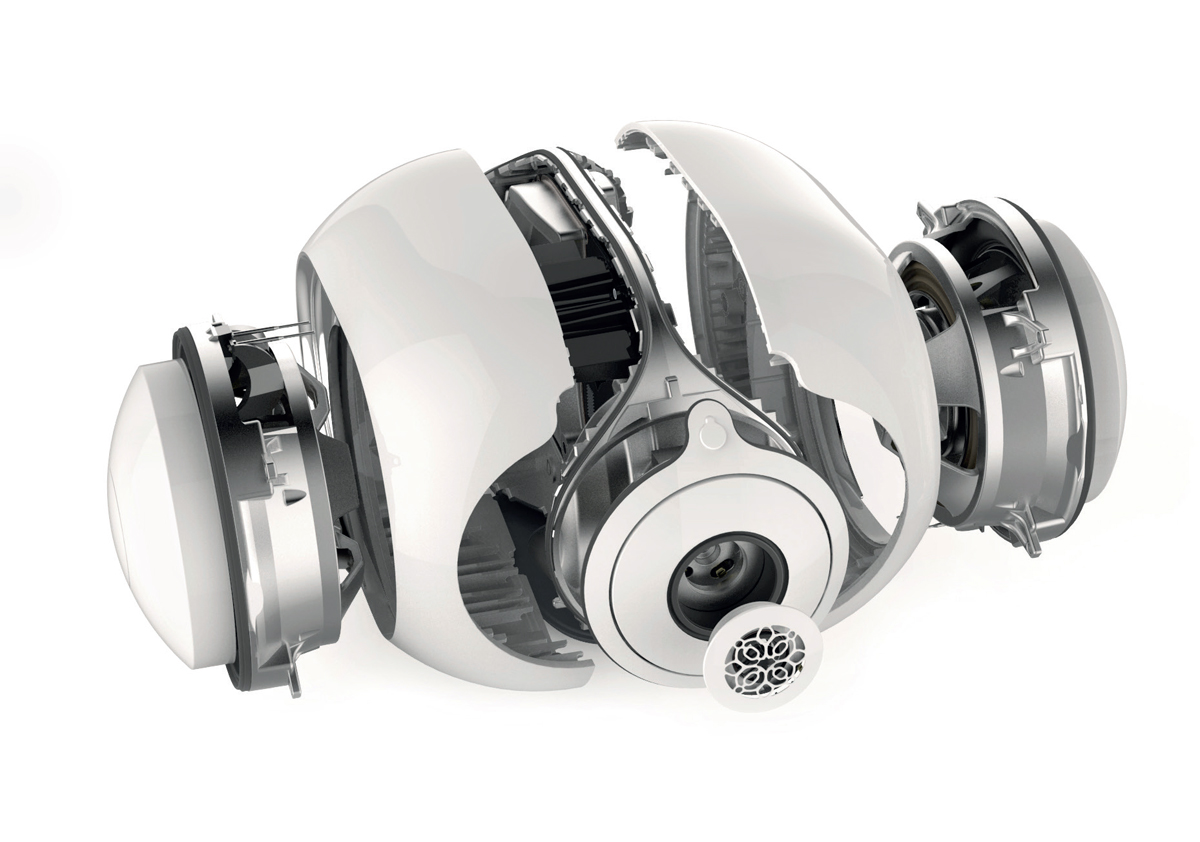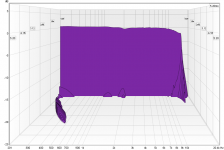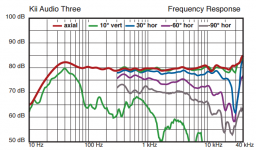Then I find it odd that the designers "goal" is precisely what would happen if he had not done anything to change the directivity. This definition of "controlled" makes it completely meaningless - just another advertising gimmick.It just means that the developer uses several techniques to "shape" the directivity as he wants it to be. When his goal was an increasing DI with frequency and he achieved that goal then his directivity is well-controlled.
Personally I prefer a higher DI.
I completely agree. People do not understand how much harder it is to get a "controlled" but "high" DI than a lower one. Heck a DI = 0 dB isn't all that hard at all. A DI of 9-12 dB is another thing altogether.
Heck a DI = 0 dB isn't all that hard at all..
..even with a horizontal limitation (ie less focus on the verticals).
Nope.
-it's not at all easy. Unless we limit the bandwidth and likely the "efficiency" and total linear output.
This will do those "hard to reach" higher freq.s:
http://www.plasmatweeter.de/eng_plasma.htm
Last edited:
Oh I see.
The SEAS DXT waveguide and opposing bass drivers in the Kii speaker are not really directivity controlling system. However the Kii 3 has quite nicely smooth but low directivity characteristics. The specific thing happens in upper bass at 60¤ (some phase cancellation?) KEF Blade and Devialet Phantom have similar construction. but with coaxial mid-tweeter.

And voilà what happen when you send 2 000 watts into a speaker ! Boum !
No, it is monopole in it's passband.
I don't know exact xo point and type. Because of no baffle help it uses huge amount of equalization in it's dsp-controlled built-in amplifiers
http://images.computeraudiophile.com/graphics/2014/1216/Devialet-PHANTOM-White%20Paper.pdf
--
Totally off-topic!
I don't know exact xo point and type. Because of no baffle help it uses huge amount of equalization in it's dsp-controlled built-in amplifiers
http://images.computeraudiophile.com/graphics/2014/1216/Devialet-PHANTOM-White%20Paper.pdf
--
Totally off-topic!
Last edited:
I think what is really internesting in the Kii 3 and different from most other constant directivity implementations (i.e. similar to Geddes) is that Bruno and the team implements directivity in the low freq.
I would guess it is quite similar to what is now a days very common in larger pro installations where you take 2 x sub front fireing, plus 1 x sub pointing to the rear, which is then delayed. This creates a cardioid directivity pattern. (google: cardioid sub arrays)
Actually this should be quite easy to try out with just 2 subwoofers pointing oposite and a mini-dsp providing the delay.
Also I think it is well thought to put 2 of the woofers on the side in the Kii 3 (these are the front fireing woofers), instead of on the front ... this gives a much smaller box to look at.
Hope to get the oppotunity to listen to the Kii 3 .... quite interesting, but could also be quite interesting to try out.
E.g. Seas 27TBCD/GB-DXT + SB Acoustics 5 inch Santori + 4 x Reckhorn DS-165 + mini-DSP + 4 challen class-d amp ..... .... of course the Kii 3 have taken a lot of research to make, and it's probably not that easy to get the same result ...
I would guess it is quite similar to what is now a days very common in larger pro installations where you take 2 x sub front fireing, plus 1 x sub pointing to the rear, which is then delayed. This creates a cardioid directivity pattern. (google: cardioid sub arrays)
Actually this should be quite easy to try out with just 2 subwoofers pointing oposite and a mini-dsp providing the delay.
Also I think it is well thought to put 2 of the woofers on the side in the Kii 3 (these are the front fireing woofers), instead of on the front ... this gives a much smaller box to look at.
Hope to get the oppotunity to listen to the Kii 3 .... quite interesting, but could also be quite interesting to try out.
E.g. Seas 27TBCD/GB-DXT + SB Acoustics 5 inch Santori + 4 x Reckhorn DS-165 + mini-DSP + 4 challen class-d amp ..... .... of course the Kii 3 have taken a lot of research to make, and it's probably not that easy to get the same result ...
I don't believe that there is extensive research of directivity behind the bass layout of Kii3. I don't believe that the response is cardioid either. The dip in 60¤ horizontal off-axis appears in crossover region to the mid and it comes from signal delay + physical time alignment. We should see full 3D power response actually. KEF Blade and Devialet Phantom are doing the same thing. Any speaker with a sideways bass driver is almost in same league, but usually xo is lower.
-
This beaming/lobing effect in upper bass may be a bad thing or a good thing based on placement of the speaker in the room. KEF Blades don't get undisputedly good reviews. I haven't seen a test of Phantoms yet, only marketing jargon.
-
This beaming/lobing effect in upper bass may be a bad thing or a good thing based on placement of the speaker in the room. KEF Blades don't get undisputedly good reviews. I haven't seen a test of Phantoms yet, only marketing jargon.
I don't believe that the response is cardioid either.
You should rethink your belief. 😉
The measurement from AUDIO magazine is a bit misleading, because there are two green curves. 10° is the one mostly covered by 0°. The other green curve is at 180°. And it clearly shows a cardioid directivity above 80 Hz. Without the DSP controlled woofers on the back this would be impossible for such a small speaker.
Attachments
Hi Juhazi. I don't think you can compare the Kii 3 with either KEF Blade or the Devialet Phantom. The big diffrence in the Kii is the two rear mounted woofers, which is driven time delayed. This is what can acomplish a cardioid response in the lower freq.
FoLLgoTT good to see the response, though somewhat disapointing in the low freq region ..... below 80 Hz .... thats where it is needed if it should do anything what so ever to standing waves ....
FoLLgoTT good to see the response, though somewhat disapointing in the low freq region ..... below 80 Hz .... thats where it is needed if it should do anything what so ever to standing waves ....
FoLLgoTT good to see the response, though somewhat disapointing in the low freq region ..... below 80 Hz .... thats where it is needed if it should do anything what so ever to standing waves ....
Directivity in the bass is a compromise in favour to a higher maximum SPL.
The big question is of course if it is possible to actually produce a cardioid or at all an directive response for low frequencies in a smal room ..... I would think not, there will always be a lot of reflection from the sides of the room, and I guess the preasure will therefore build up anyway ......
Outside in at a rock concert it is ofcourse a lot different 🙂
Outside in at a rock concert it is ofcourse a lot different 🙂
So I think we are back to Geddes multiple subs to produce good bass in a small room 🙂
Or a Double Bass Array which is much more linear and spatially constant.
But not nearly as practical and quite frankly overkill. Multiple subs works amazingly well for such a simple technique. Certainly sufficiently "linear and spatially constant". And I don't accept the adjective "much more".
But not nearly as practical and quite frankly overkill. Multiple subs works amazingly well for such a simple technique. Certainly sufficiently "linear and spatially constant".
I never denied that.
And I don't accept the adjective "much more".
A working DBA has a nearly constant frequency response in the whole room with extremely fast decay. No subwoofer system I know of is better than that (not even close). In fact it can't be better than that. It lets the room disappear completely.
For music it may be overkill, I agree. For a home theater it is the perfect bass system. It can be installed invisibly behind the screen and build as flat enclosures. It is invisible and no useful room on the floor is wasted.
And btw. a DBA doesn't necessarily consists of 8 subwoofers. 4 may be enough in most rooms as I evaluated here.
Last edited:
I stand corrected about Kii 3 bass system! Obviously rearside drivers are delay matched to sides (reverse phase). And obviously there is delay also for front mid and tweeter plus appropriate transfer functions to arrive in one-knee step response. However the peak of the step impulse is ragged.
It lets the room disappear completely.
I would argue, along with Dr. Griesinger, that what one wants in the bass is waves that move around you going in all directions. He claims, and I agree, that this yields "envelopment". Multiple subs around the room does precisely that, (as well as smoothing the response in both frequency and space.) The DBA does precisely the opposite (in regards to wavefront motion.)
An anechoic chamber is a terrible place to listen to music - in the bass or otherwise.
I would argue, along with Dr. Griesinger, that what one wants in the bass is waves that move around you going in all directions. He claims, and I agree, that this yields "envelopment". Multiple subs around the room does precisely that, (as well as smoothing the response in both frequency and space.) The DBA does precisely the opposite (in regards to wavefront motion.)
Yes, the wave front of a DBA has a direction. And from my experience (and of many others) this direction gives a special "punch". When watching a movie it is a different perception than a bass that comes from everywhere. This special "hit" directly in the face from a DBA is much more preferable to most people. It is ab bit like an open-air concert.
We had much discussion in a german home theater forum where many of us have build a DBA. All agree that the directed wave front out of the screen is preferable.
An anechoic chamber is a terrible place to listen to music - in the bass or otherwise.
A DBA doesn't make the room absorbent. It leaves its decay completely intact. It has nothing to do with listening in an anechoic chamber.
The bass is very neutral, "fast" and detailed. There is no boominess. It sounds just perfect with music.
Last edited:
Lots of claims, all of which I could quote about the use of multiple subs.
I fail to understand how you can make such all encompassing claims without the slightest bit of evidence.
DBA is much more preferable to most people
I fail to understand how you can make such all encompassing claims without the slightest bit of evidence.
I guess nobody read first post of thread that I linked to.
The speaker is most similar to Kii speaker linked by OP; it is relatively small, and fully exploits DSP in achieving implementation of cardioid pattern from roughly 100Hz, to 2kHz.
Relative to other speakers I've worked with, this one makes speaker and room disappear with the greatest freedom in speaker placement. Imaging is superb, and male voice the most natural sounding. As implemented, weakness is SPL capability.
Kii Three with sealed drivers, and more surface area is neat idea.
The waterfall plot shown is nothing special though <2kHz; this could be do to driver layout and requisite DSP to get cardioid pattern from sealed drivers. My cardioid arrangement has excellent waterfall:

The speaker is most similar to Kii speaker linked by OP; it is relatively small, and fully exploits DSP in achieving implementation of cardioid pattern from roughly 100Hz, to 2kHz.
Relative to other speakers I've worked with, this one makes speaker and room disappear with the greatest freedom in speaker placement. Imaging is superb, and male voice the most natural sounding. As implemented, weakness is SPL capability.
Kii Three with sealed drivers, and more surface area is neat idea.
The waterfall plot shown is nothing special though <2kHz; this could be do to driver layout and requisite DSP to get cardioid pattern from sealed drivers. My cardioid arrangement has excellent waterfall:

- Home
- Loudspeakers
- Multi-Way
- Any controlled directivity DIYs?
